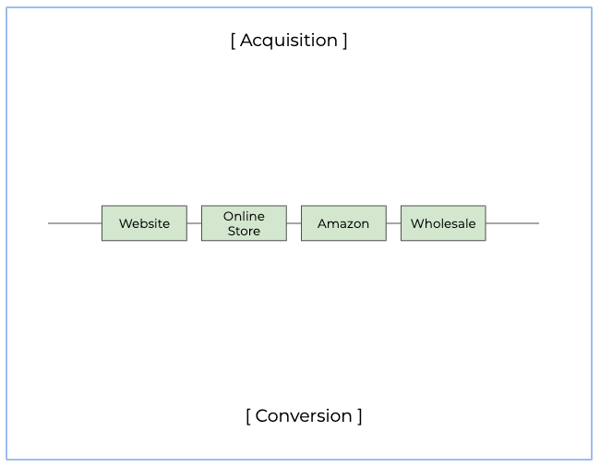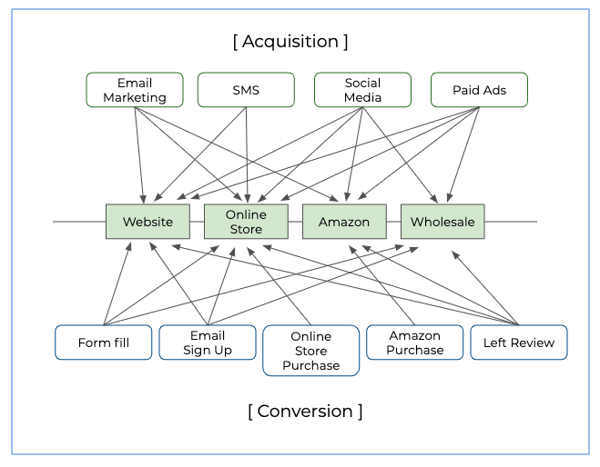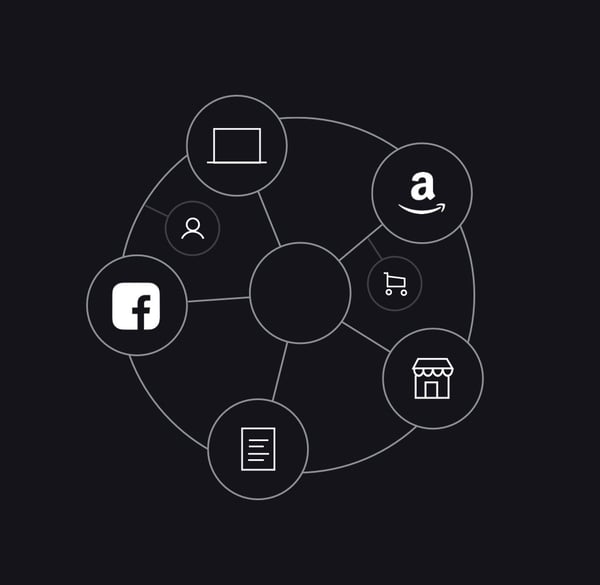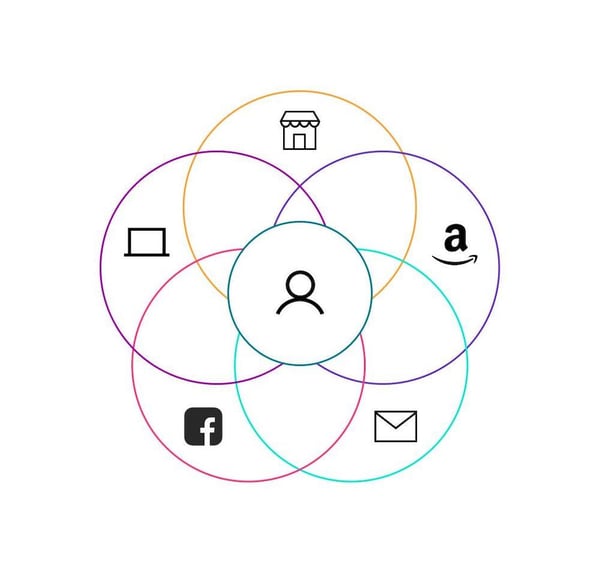In omni-channel marketing, all your marketing efforts, all your customer touch points, and all your points of sale work together to create a fluid shopping experience for your customer.
But what does omni-channel marketing look like?
Let’s follow a consumer through his day as he engages with an omni-channel marketing strategy.
Your target consumer gets bored while working, grabs his phone for a quick dopamine hit on Instagram, interacts with a paid ad, and winds up in your brand’s omni-channel marketing web.
Now your brand is able to follow him as he turns his attention back to his computer, Googles a recipe for his upcoming 4th of July party, and clicks in to learn more about how to make the perfect smoked deviled eggs.
Because this recipe website is part of the Google Display Network, your ads are displaying in the sidebar of the recipe.
Instead of being the same content as the ad he just saw on Instagram, this is new content that encourages him to get to know your brand further.
His curiosity is piqued and he clicks the ad to learn more.
The ad takes him to your website (which has great load times and highly optimized content) and he’s hooked. Every word on your site makes him excited. He needs what you have!
He’s ready to buy and heads to the checkout to make a purchase. Unfortunately, your margins don’t allow you to offer free shipping and he has come to expect free shipping when ordering online. So he bails on his cart and goes back to his work day.
Luckily, however, before he closes the window, your email newsletter pops up to save the day. It asks him if he wants to sign up for news and future promotions.
He is really very interested in your product so he signs up for your email, intending to wait on making a purchase until a good sale comes along.
Later that night, he is watching Netflix and checking emails on his phone. He opens your newsletter welcome email and sees a discount code that will help him save 10% on his first purchase.
With a few quick calculations, he determines that saving the 10% with his coupon code will roughly offset the price of shipping. He’s interested and saves the email and goes back to watching his show.
An hour later, he opens Instagram. There in his feed is a video ad giving a glowing review of the exact product he knows he wants and needs.
He gives in and clicks the ad. He enters the coupon code from the welcome email and the discount is applied. Voila! You finally got him.
He hands over his shipping and billing information and completes his purchase.
This is a terrible omni-channel marketing experience in a nutshell.
Omni-channel marketing vs multi-channel marketing
There is a distinct difference between multi-channel marketing and omni-channel marketing.
Even though they use the same marketing tools, the underlying structure of the strategy that goes into each is different.
Multi-channel marketing
Think about traditional marketing like a wheel.
Your product sits at the center and all of the efforts you’re using to drive awareness and demand for your product make up the spokes — like this graphic from Shopify helps illustrate.
This product-centered model works just fine if your product is the focus of your business and the goal of your marketing is product-centered.
However, this model fails to account for the fact that we’re marketing in a consumer-first world.
Omni-channel marketing
In contrast to the multi-channel wheel outlined above, omni-channel marketing puts the consumer at the middle of the ecosystem and overlaps the channels that the consumer engages with.
The goal is to stay top-of-mind for your consumer as they live their lives across many different channels where you market your brand.
“The purpose [of omni-channel marketing] is to keep customers moving around within the brand ecosystem, with each channel working in harmony to nurture more sales and engagement.” – Square
There are plenty of great examples of omni-channel marketing strategy out in the wild.
In fact, you’re likely experiencing omni-channel advertising from some of your favorite brands right now.
HubSpot has a great article highlighting some great omni-channel experiences. From Disney to REI to Chipotle, there are major brands across all industries making use of the omni-channel marketing mix.
And they’re doing it because it works.
Why cross-channel collaboration is a must
The reason omni-channel works so well is because the marketing strategies behind an omni experience ensure that all touch points the consumer has with your brand are in-sync with each other.
They are cohesive to prevent mixed messaging and create one continuous journey.
The user is able to go about their digital life and receive consistent, persistent nudges from your brand along the way.
When they are ready, they can purchase in the channel that is most convenient for them — whether it’s following an email link to your company website, clicking a Google Shopping ad, engaging with the “Shop now” call-to-action in an Instagram story ad, or snagging your product off the shelf at a retailer.
The idea is to fit more naturally and seamlessly into someone’s routine, not interrupt it.
Keeping consumer attention
An omni-channel marketing campaign also helps to combat the attention deficit that humanity suffers from in our over-saturated, digital world.
While an email campaign may reach a person and pique interest, she might do a quick Google search to check the price of your product against competitors, get distracted by an unrelated search result, and forget that she was interested in your offer to begin with.
Incorporating paid media into the marketing campaign allows you to follow her online journey and remind her about your brand and product, even when she’s distracted from your email marketing.
Investing in an advocacy and influencer program could help grab her attention again when she’s on Facebook or Instagram later in the day.
The social proof from influencers could help push her back to your website to purchase.
How to start omni-channel marketing for your brand
There isn’t an industry out there that won’t benefit from a customer-centric strategy like omni-channel marketing.
It may seem overwhelming at first, but taking things one step at a time can help limit anxiety.
Here’s a step-by-step process to help you with the strategy build out.
1. To start, I’d recommend making some lists.
Start with all the places your customer can convert.
Some ideas to get you started:
Website
Online store
Amazon
Brick and mortar shop
Retailers / Wholesale channels
Pop-up store
Then, list all of your existing marketing channels and efforts.
This might include:
On-page content
Blog posts
Organic social media
Email marketing
SMS marketing
Retargeting (such as AdRoll, Criteo)
Paid ads (PPC and social)
Experiential / in-person
Referrals / reviews (social proof)
Finally, jot down all the ways a person can convert with your brand.
These are conversion actions that the user takes, not the environment where the conversion happens. Maybe some of the following:
Form-fill on website
Phone call
Email sign up
Purchase in online store
Amazon purchase
In-store purchase
Leave a review (on your website, Google My Business, etc.)
2. Once you have your lists, prep your “map.”
I like to work with a program like LucidChart to help me visualize how everything works together.
To start:
Divide your workspace in half with a horizontal line.
At the top of your workspace, high above the line, write “Acquisition” nice and big.
At the bottom of your workspace, right at the bottom, write “Conversion” nice and big.
Along the line, write down your conversion locations .
You should get something that looks like this:

Once you have your framework set up:
Revisit your list of existing marketing channels and efforts.
Write them all down in the space under “Acquisition.”
Then same thing for your conversions list.
Now draw a line from every acquisition and conversion item to any and all conversion places (along your horizontal line) as is fitting.

You now have a (crazy-looking) map for your omni-channel strategy.
Every conversion place that is touched by two or more acquisition arrows can use an omni-channel marketing approach to aid in awareness and conversions.
3. Use the map to build your strategy
Now that you have your omni-channel map, you can use it as a tool to help inform your next marketing campaign strategy.
For example, let’s say your campaign goal is to drive form fills on your website.
The “website” conversion place is touched by email marketing, SMS, social media, and paid ads.
Knowing this, you can focus on building out a marketing strategy that weaves all four channels together with consistent messaging as the user encounters each advertisement throughout their buyer journey.
Key questions to consider as you build your strategy:
How many channels are being used to engage with the user?
When is the user touching each channel during their buyer journey?
Is your messaging on each channel customized for that part of their journey?
Could you add more touch points? Should you take any away?
How is your tracking as the user moves between channels?
Once you have documented the channels you will be using and the parts of the funnel or buyer’s journey that each channel will touch, you’re ready to start implementing.
When in doubt, try it out!
Following the steps above is just scratching the surface of the omni-channel marketing experience, but we all have to start somewhere!
Make sure you have great tracking in place so you can tell what’s working and what’s not.
Always be testing, validating your results, and scaling where you see success.
And as always, let us know how it goes for you. We’re here for you in IMPACT Elite and happy to help.
![]()
Read more: impactbnd.com


